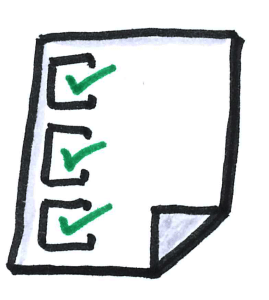
Are you ready for your pitch? This pitch deck checklist will help you cover all the bases.
We often emphasize that the secret to a great pitch is sufficient preparation. As you know, the most compelling speakers won’t face an audience expecting they can “wing it”. What makes their pitches so memorable is the fact that they took the time to craft their message. Just take a look at Steve Jobs, who was known to have spent hours practicing and perfecting his keynotes.
Thought leader Michael Hyatt says it best:
“The reason I do a good job is because I prepare. I don’t believe in ‘winging it’.”
While it may take up much of your time, preparation is the best way to a successful outcome. It’s not enough to string together a bunch of slides. You need to dig deeper if you want to provide the audience with a complete and informative discussion. Here’s a pitch deck checklist to help with your preparation:
1. Identify the goal you want to achieve
Before you take on any other task, the first thing you need to do is identify the purpose of your pitch. What is the end goal? What would you consider a successful outcome? What’s the ultimate takeaway that you want your audience to remember? What is your core message? Answering these questions will give you a clear direction for your pitch deck.
2. Learn more about your audience
The audience is a crucial part of your pitch. This may seem pretty obvious, but some do tend to ignore the importance of their role. That’s why a lot of us have sat through pitches that seemed too long and tedious. If you want to give your audience an experience that’s totally different from the usual scenario, you need to learn more about where they’re coming from.
The people in your audience have the power to accept or dismiss the message you’re sharing. If you want to connect with them, you need to learn more about their point of view. Where are they coming from? What are their backgrounds? How much do they know about the topic you’re presenting? You can use this guide to make sure you answer all the important question about your audience.
Another thing you should consider is the event or conference you’re participating in. What type of event is it? Is it an industry event where you’re expected to address professionals? Is it a seminar for aspiring leaders looking for inspiration and motivation? By learning the culture of a particular event, you can better understand how to communicate with your audience.
3. Create an outline of your initial ideas
Having established context, you’ll find it easier to form some great ideas. Let your pitch deck take shape by using different brainstorming methods. Whatever you decide to use, make sure you keep writing down everything that comes to mind. Don’t attempt to edit anything out until you’ve exhausted all your ideas.
After brainstorming, you can take your initial ideas and turn them into a rough outline. Review what you’ve written and decide which points stand out the most. You can also rearrange what you’ve written to give your points a clear and logical flow. From there, you can eventually make a pitch deck storyboard.
4. Fine-tune your content
Once you have a rough outline for your pitch deck, it’s time to bolster your message with strong pitch content. You can’t just present your ideas through a series of bullet points. You need to present your message through content that tells a story.
As you write your content, always remember your core message. Make sure the goal you’ve established is clearly highlighted on all the points you make. Keep your content well-structured and make sure you don’t include an overwhelming amount of information. You’ll need to discern which of the information you have is the most important to your overall objective.
5. Design a compelling pitch deck
We’ve always emphasized how important visuals are to pitch decks. To keep your audience engaged, you’ll need to create a pitch deck that can emphasize your message while following the principles of design.
Generally, it’s important to keep pitch deck designs simple and concise. Use minimal text and high quality pictures. Everything in your design should cohere to the story you’re trying to tell. If you’re pitching sales prospects, make sure your brand is leveraged by your slides. If you really want the best of your story to stand out, consulting with a pitch deck expert will be a big help.
6. Plan your pitch wear
As we’ve written in the past, first impressions are crucial in pitching. The audience can quickly decide on your credibility based on how you present yourself. To avoid giving them a bad impression, you need to maintain a polished and professional look. A sloppy attire will make you lose the credibility you want to achieve.
Appropriate attire will depend on the context of your pitch deck, so take note of the information you have about the event. The easiest way to gauge what you should wear is by thinking about your audience. As a general rule, Forbes contributor Nick Morgan said that you should be dressed slightly better than your audience.
7. Internalize your entire pitch deck
With everything else prepared, it’s time to internalize every detail of your pitch deck. If you want to avoid committing mistakes, you need to rehearse your pitch as much as you can. Practice helps you become more familiar with your material. Review your speech, plan how you’ll incorporate your pitch deck, and think about how you’ll deliver everything on stage. Interruptions won’t phase you if you’re sure of what you need to do.
It’s important to prepare as much as you can for any pitch. If you want to deliver a message with noticeable impact, you can’t risk to miss any step. Use this pitch deck checklist as a guide to make sure you cover all the bases and accomplishing everything you need.
Featured Image: Chris Lott via Flickr
Illustration: Oliver Tacke via Flickr









